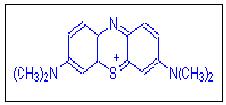Basic dyes are the class of dyes, that are most
commonly synthetic. Their primary nature is to act as bases, and are
actually aniline dyes. Initially their color base prevents them from
being water soluble. They can be made so with the base being converted
into a salt. At the chemical level, basic dyes are typically cationic or
positively charged. Basic dyes display cationic functional groups like
-NR3+ or =NR2+. Since basic dye is a stain that is cationic or
positively charged and it is the reason that it reacts well with
material that is anionic or negatively charged.
Basic dyes consists of amino groups, or alkylamino groups, as their
auxochromes. Synthetic dye that was discovered by Perkin incidentally
was a basic dye. Some prominent examples of basic dyes are the
following, methylene blue, crystal violet, basic fuchsin safranin, etc.
An example of a basic dye that has amino groups as their auxochrome is
pararosanilin or basic red 9 (according to the strict colour index
system of classification) example of alkylamino groups is methylene blue
or basic blue 9. Basic Blue 9 is a very popular dye that has vast use.
The following table gives a few vital information regarding the dye
basic blue 9.

